Human Resource Development Report
VerifiedAdded on 2020/07/22
|13
|3111
|40
Report
AI Summary
This report delves into the significance of human resource development within HSBC, highlighting various training methods, learning styles, and the impact of UK government initiatives on employee training. It discusses the importance of adapting training to meet the needs of a diverse workforce and evaluates the effectiveness of different training approaches. The report emphasizes the role of learning theories in enhancing employee performance and organizational success.

Human resource development
Paraphrase This Document
Need a fresh take? Get an instant paraphrase of this document with our AI Paraphraser
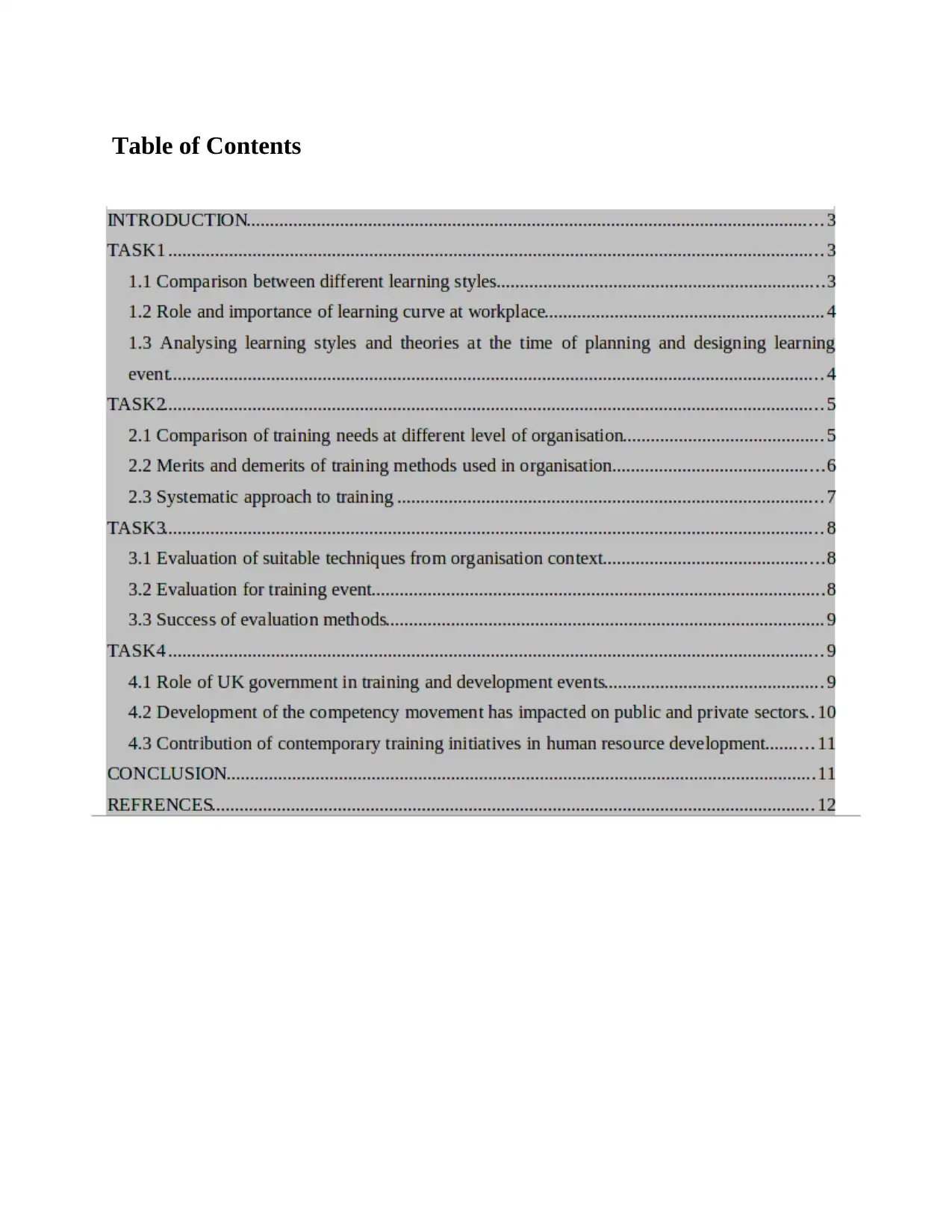
Table of Contents
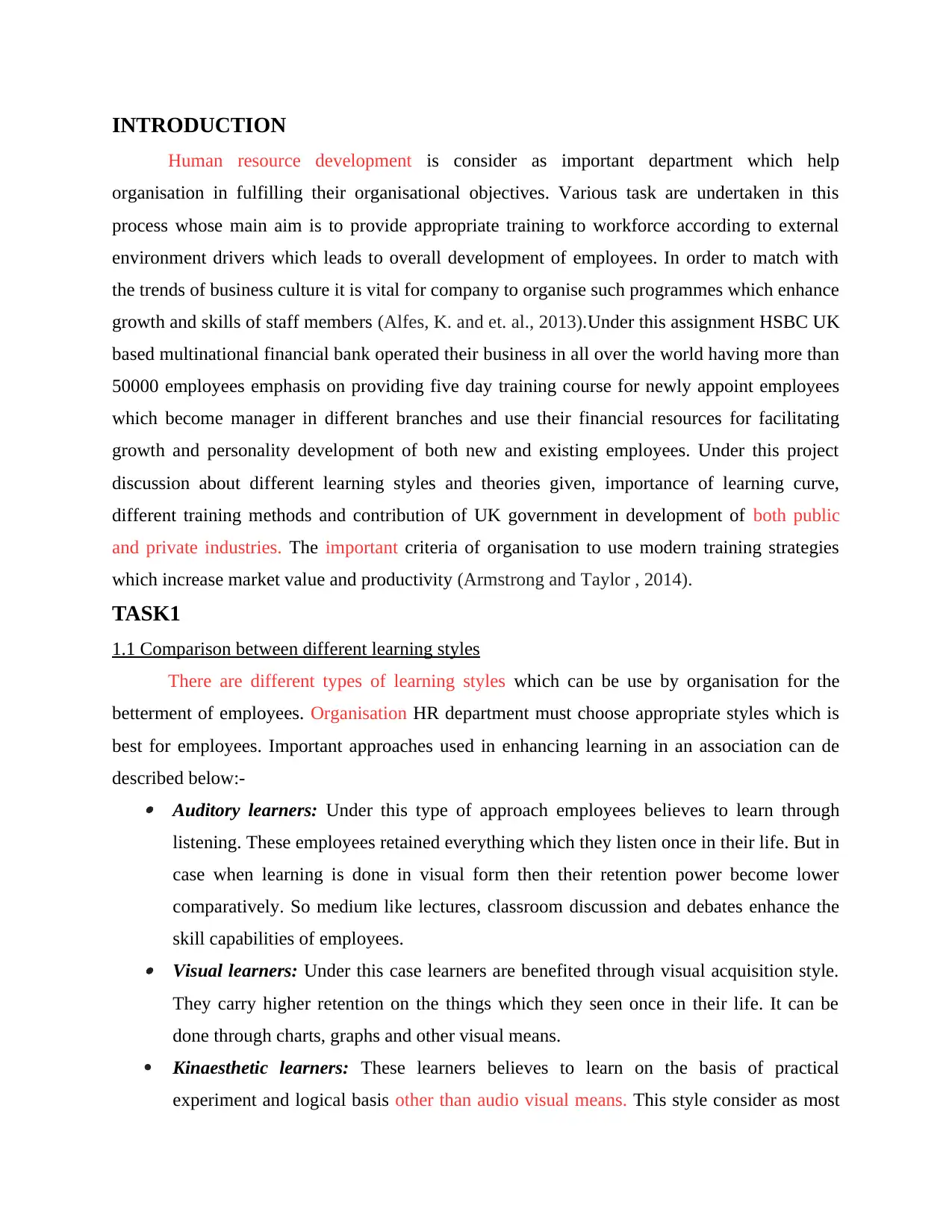
INTRODUCTION
Human resource development is consider as important department which help
organisation in fulfilling their organisational objectives. Various task are undertaken in this
process whose main aim is to provide appropriate training to workforce according to external
environment drivers which leads to overall development of employees. In order to match with
the trends of business culture it is vital for company to organise such programmes which enhance
growth and skills of staff members (Alfes, K. and et. al., 2013).Under this assignment HSBC UK
based multinational financial bank operated their business in all over the world having more than
50000 employees emphasis on providing five day training course for newly appoint employees
which become manager in different branches and use their financial resources for facilitating
growth and personality development of both new and existing employees. Under this project
discussion about different learning styles and theories given, importance of learning curve,
different training methods and contribution of UK government in development of both public
and private industries. The important criteria of organisation to use modern training strategies
which increase market value and productivity (Armstrong and Taylor , 2014).
TASK1
1.1 Comparison between different learning styles
There are different types of learning styles which can be use by organisation for the
betterment of employees. Organisation HR department must choose appropriate styles which is
best for employees. Important approaches used in enhancing learning in an association can de
described below:- Auditory learners: Under this type of approach employees believes to learn through
listening. These employees retained everything which they listen once in their life. But in
case when learning is done in visual form then their retention power become lower
comparatively. So medium like lectures, classroom discussion and debates enhance the
skill capabilities of employees. Visual learners: Under this case learners are benefited through visual acquisition style.
They carry higher retention on the things which they seen once in their life. It can be
done through charts, graphs and other visual means.
Kinaesthetic learners: These learners believes to learn on the basis of practical
experiment and logical basis other than audio visual means. This style consider as most
Human resource development is consider as important department which help
organisation in fulfilling their organisational objectives. Various task are undertaken in this
process whose main aim is to provide appropriate training to workforce according to external
environment drivers which leads to overall development of employees. In order to match with
the trends of business culture it is vital for company to organise such programmes which enhance
growth and skills of staff members (Alfes, K. and et. al., 2013).Under this assignment HSBC UK
based multinational financial bank operated their business in all over the world having more than
50000 employees emphasis on providing five day training course for newly appoint employees
which become manager in different branches and use their financial resources for facilitating
growth and personality development of both new and existing employees. Under this project
discussion about different learning styles and theories given, importance of learning curve,
different training methods and contribution of UK government in development of both public
and private industries. The important criteria of organisation to use modern training strategies
which increase market value and productivity (Armstrong and Taylor , 2014).
TASK1
1.1 Comparison between different learning styles
There are different types of learning styles which can be use by organisation for the
betterment of employees. Organisation HR department must choose appropriate styles which is
best for employees. Important approaches used in enhancing learning in an association can de
described below:- Auditory learners: Under this type of approach employees believes to learn through
listening. These employees retained everything which they listen once in their life. But in
case when learning is done in visual form then their retention power become lower
comparatively. So medium like lectures, classroom discussion and debates enhance the
skill capabilities of employees. Visual learners: Under this case learners are benefited through visual acquisition style.
They carry higher retention on the things which they seen once in their life. It can be
done through charts, graphs and other visual means.
Kinaesthetic learners: These learners believes to learn on the basis of practical
experiment and logical basis other than audio visual means. This style consider as most
⊘ This is a preview!⊘
Do you want full access?
Subscribe today to unlock all pages.

Trusted by 1+ million students worldwide
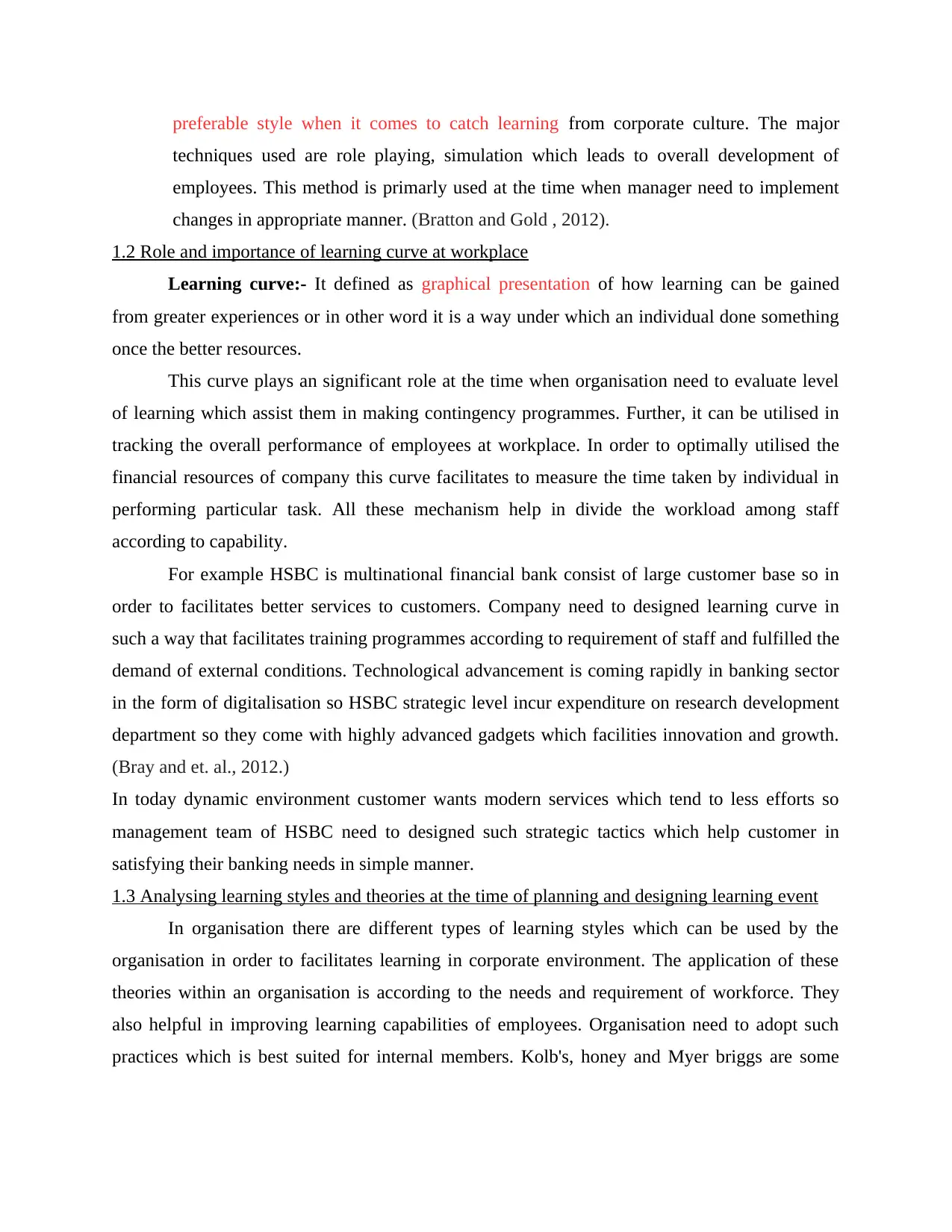
preferable style when it comes to catch learning from corporate culture. The major
techniques used are role playing, simulation which leads to overall development of
employees. This method is primarly used at the time when manager need to implement
changes in appropriate manner. (Bratton and Gold , 2012).
1.2 Role and importance of learning curve at workplace
Learning curve:- It defined as graphical presentation of how learning can be gained
from greater experiences or in other word it is a way under which an individual done something
once the better resources.
This curve plays an significant role at the time when organisation need to evaluate level
of learning which assist them in making contingency programmes. Further, it can be utilised in
tracking the overall performance of employees at workplace. In order to optimally utilised the
financial resources of company this curve facilitates to measure the time taken by individual in
performing particular task. All these mechanism help in divide the workload among staff
according to capability.
For example HSBC is multinational financial bank consist of large customer base so in
order to facilitates better services to customers. Company need to designed learning curve in
such a way that facilitates training programmes according to requirement of staff and fulfilled the
demand of external conditions. Technological advancement is coming rapidly in banking sector
in the form of digitalisation so HSBC strategic level incur expenditure on research development
department so they come with highly advanced gadgets which facilities innovation and growth.
(Bray and et. al., 2012.)
In today dynamic environment customer wants modern services which tend to less efforts so
management team of HSBC need to designed such strategic tactics which help customer in
satisfying their banking needs in simple manner.
1.3 Analysing learning styles and theories at the time of planning and designing learning event
In organisation there are different types of learning styles which can be used by the
organisation in order to facilitates learning in corporate environment. The application of these
theories within an organisation is according to the needs and requirement of workforce. They
also helpful in improving learning capabilities of employees. Organisation need to adopt such
practices which is best suited for internal members. Kolb's, honey and Myer briggs are some
techniques used are role playing, simulation which leads to overall development of
employees. This method is primarly used at the time when manager need to implement
changes in appropriate manner. (Bratton and Gold , 2012).
1.2 Role and importance of learning curve at workplace
Learning curve:- It defined as graphical presentation of how learning can be gained
from greater experiences or in other word it is a way under which an individual done something
once the better resources.
This curve plays an significant role at the time when organisation need to evaluate level
of learning which assist them in making contingency programmes. Further, it can be utilised in
tracking the overall performance of employees at workplace. In order to optimally utilised the
financial resources of company this curve facilitates to measure the time taken by individual in
performing particular task. All these mechanism help in divide the workload among staff
according to capability.
For example HSBC is multinational financial bank consist of large customer base so in
order to facilitates better services to customers. Company need to designed learning curve in
such a way that facilitates training programmes according to requirement of staff and fulfilled the
demand of external conditions. Technological advancement is coming rapidly in banking sector
in the form of digitalisation so HSBC strategic level incur expenditure on research development
department so they come with highly advanced gadgets which facilities innovation and growth.
(Bray and et. al., 2012.)
In today dynamic environment customer wants modern services which tend to less efforts so
management team of HSBC need to designed such strategic tactics which help customer in
satisfying their banking needs in simple manner.
1.3 Analysing learning styles and theories at the time of planning and designing learning event
In organisation there are different types of learning styles which can be used by the
organisation in order to facilitates learning in corporate environment. The application of these
theories within an organisation is according to the needs and requirement of workforce. They
also helpful in improving learning capabilities of employees. Organisation need to adopt such
practices which is best suited for internal members. Kolb's, honey and Myer briggs are some
Paraphrase This Document
Need a fresh take? Get an instant paraphrase of this document with our AI Paraphraser
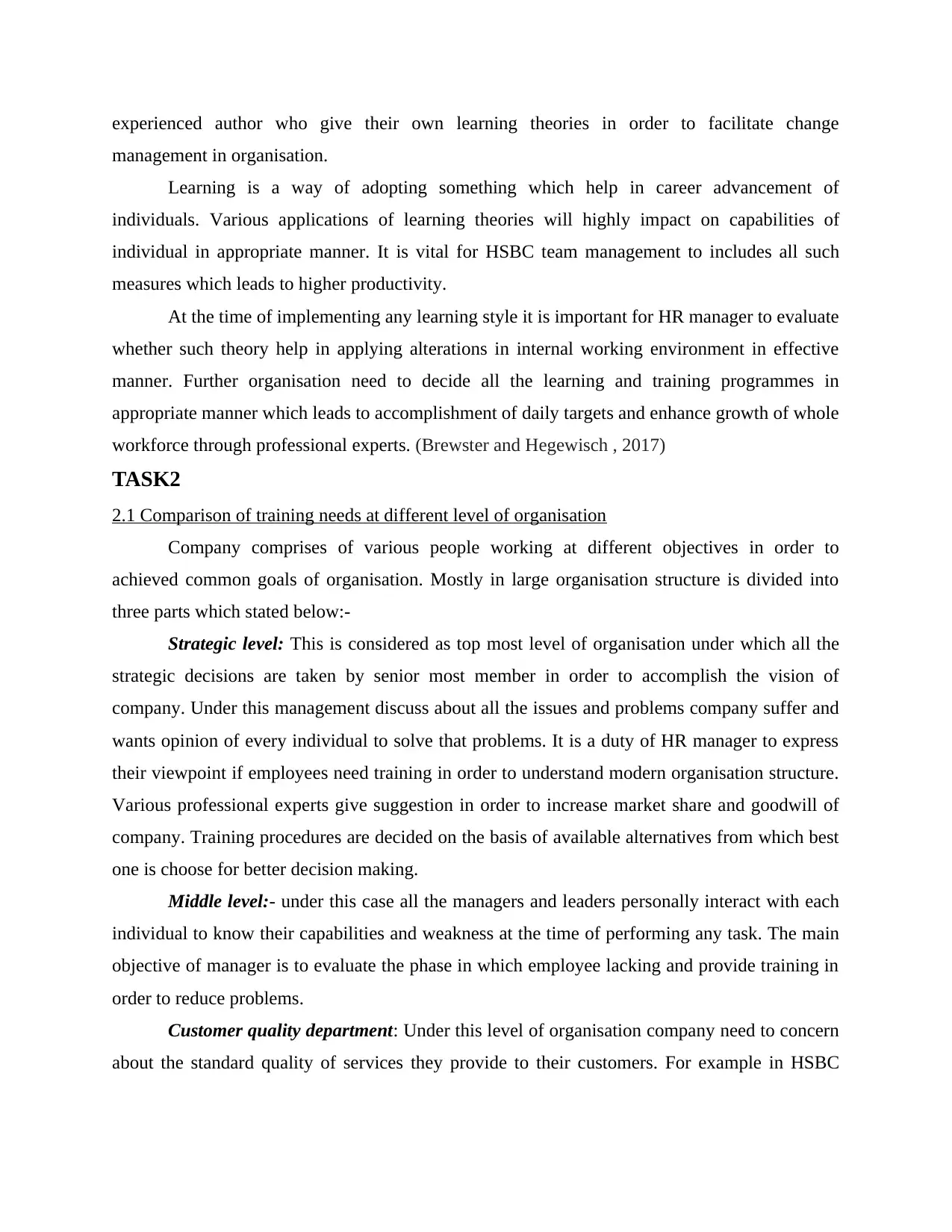
experienced author who give their own learning theories in order to facilitate change
management in organisation.
Learning is a way of adopting something which help in career advancement of
individuals. Various applications of learning theories will highly impact on capabilities of
individual in appropriate manner. It is vital for HSBC team management to includes all such
measures which leads to higher productivity.
At the time of implementing any learning style it is important for HR manager to evaluate
whether such theory help in applying alterations in internal working environment in effective
manner. Further organisation need to decide all the learning and training programmes in
appropriate manner which leads to accomplishment of daily targets and enhance growth of whole
workforce through professional experts. (Brewster and Hegewisch , 2017)
TASK2
2.1 Comparison of training needs at different level of organisation
Company comprises of various people working at different objectives in order to
achieved common goals of organisation. Mostly in large organisation structure is divided into
three parts which stated below:-
Strategic level: This is considered as top most level of organisation under which all the
strategic decisions are taken by senior most member in order to accomplish the vision of
company. Under this management discuss about all the issues and problems company suffer and
wants opinion of every individual to solve that problems. It is a duty of HR manager to express
their viewpoint if employees need training in order to understand modern organisation structure.
Various professional experts give suggestion in order to increase market share and goodwill of
company. Training procedures are decided on the basis of available alternatives from which best
one is choose for better decision making.
Middle level:- under this case all the managers and leaders personally interact with each
individual to know their capabilities and weakness at the time of performing any task. The main
objective of manager is to evaluate the phase in which employee lacking and provide training in
order to reduce problems.
Customer quality department: Under this level of organisation company need to concern
about the standard quality of services they provide to their customers. For example in HSBC
management in organisation.
Learning is a way of adopting something which help in career advancement of
individuals. Various applications of learning theories will highly impact on capabilities of
individual in appropriate manner. It is vital for HSBC team management to includes all such
measures which leads to higher productivity.
At the time of implementing any learning style it is important for HR manager to evaluate
whether such theory help in applying alterations in internal working environment in effective
manner. Further organisation need to decide all the learning and training programmes in
appropriate manner which leads to accomplishment of daily targets and enhance growth of whole
workforce through professional experts. (Brewster and Hegewisch , 2017)
TASK2
2.1 Comparison of training needs at different level of organisation
Company comprises of various people working at different objectives in order to
achieved common goals of organisation. Mostly in large organisation structure is divided into
three parts which stated below:-
Strategic level: This is considered as top most level of organisation under which all the
strategic decisions are taken by senior most member in order to accomplish the vision of
company. Under this management discuss about all the issues and problems company suffer and
wants opinion of every individual to solve that problems. It is a duty of HR manager to express
their viewpoint if employees need training in order to understand modern organisation structure.
Various professional experts give suggestion in order to increase market share and goodwill of
company. Training procedures are decided on the basis of available alternatives from which best
one is choose for better decision making.
Middle level:- under this case all the managers and leaders personally interact with each
individual to know their capabilities and weakness at the time of performing any task. The main
objective of manager is to evaluate the phase in which employee lacking and provide training in
order to reduce problems.
Customer quality department: Under this level of organisation company need to concern
about the standard quality of services they provide to their customers. For example in HSBC
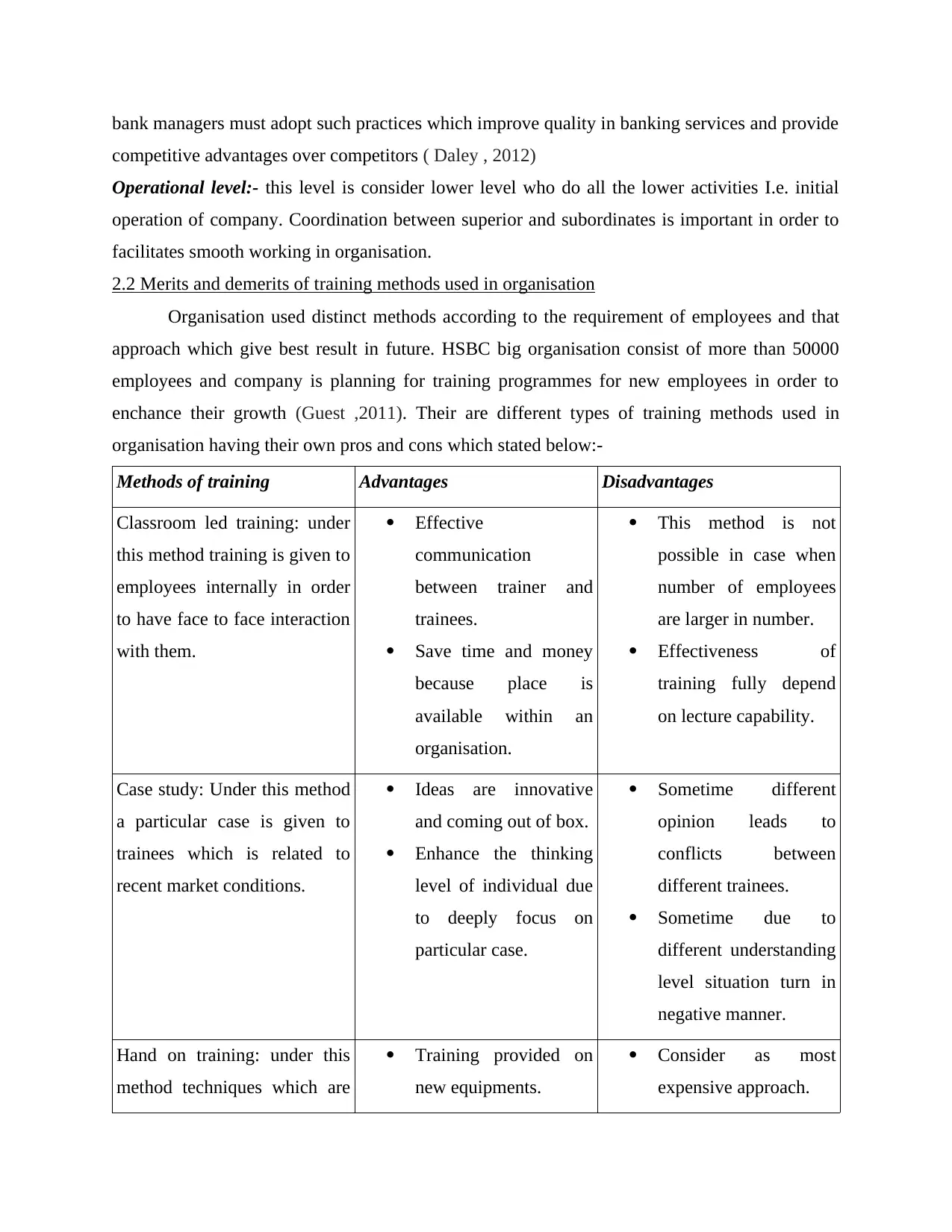
bank managers must adopt such practices which improve quality in banking services and provide
competitive advantages over competitors ( Daley , 2012)
Operational level:- this level is consider lower level who do all the lower activities I.e. initial
operation of company. Coordination between superior and subordinates is important in order to
facilitates smooth working in organisation.
2.2 Merits and demerits of training methods used in organisation
Organisation used distinct methods according to the requirement of employees and that
approach which give best result in future. HSBC big organisation consist of more than 50000
employees and company is planning for training programmes for new employees in order to
enchance their growth (Guest ,2011). Their are different types of training methods used in
organisation having their own pros and cons which stated below:-
Methods of training Advantages Disadvantages
Classroom led training: under
this method training is given to
employees internally in order
to have face to face interaction
with them.
Effective
communication
between trainer and
trainees.
Save time and money
because place is
available within an
organisation.
This method is not
possible in case when
number of employees
are larger in number.
Effectiveness of
training fully depend
on lecture capability.
Case study: Under this method
a particular case is given to
trainees which is related to
recent market conditions.
Ideas are innovative
and coming out of box.
Enhance the thinking
level of individual due
to deeply focus on
particular case.
Sometime different
opinion leads to
conflicts between
different trainees.
Sometime due to
different understanding
level situation turn in
negative manner.
Hand on training: under this
method techniques which are
Training provided on
new equipments.
Consider as most
expensive approach.
competitive advantages over competitors ( Daley , 2012)
Operational level:- this level is consider lower level who do all the lower activities I.e. initial
operation of company. Coordination between superior and subordinates is important in order to
facilitates smooth working in organisation.
2.2 Merits and demerits of training methods used in organisation
Organisation used distinct methods according to the requirement of employees and that
approach which give best result in future. HSBC big organisation consist of more than 50000
employees and company is planning for training programmes for new employees in order to
enchance their growth (Guest ,2011). Their are different types of training methods used in
organisation having their own pros and cons which stated below:-
Methods of training Advantages Disadvantages
Classroom led training: under
this method training is given to
employees internally in order
to have face to face interaction
with them.
Effective
communication
between trainer and
trainees.
Save time and money
because place is
available within an
organisation.
This method is not
possible in case when
number of employees
are larger in number.
Effectiveness of
training fully depend
on lecture capability.
Case study: Under this method
a particular case is given to
trainees which is related to
recent market conditions.
Ideas are innovative
and coming out of box.
Enhance the thinking
level of individual due
to deeply focus on
particular case.
Sometime different
opinion leads to
conflicts between
different trainees.
Sometime due to
different understanding
level situation turn in
negative manner.
Hand on training: under this
method techniques which are
Training provided on
new equipments.
Consider as most
expensive approach.
⊘ This is a preview!⊘
Do you want full access?
Subscribe today to unlock all pages.

Trusted by 1+ million students worldwide
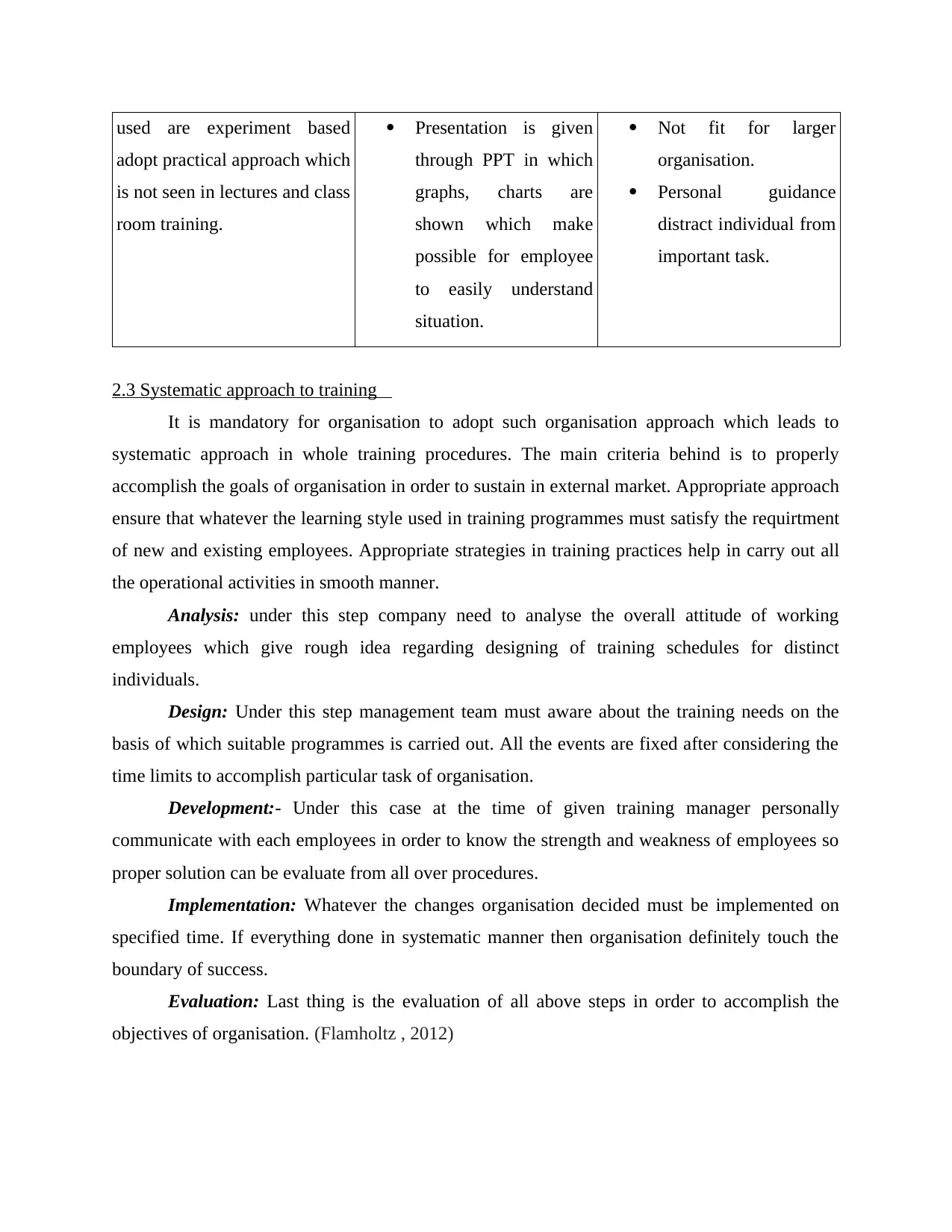
used are experiment based
adopt practical approach which
is not seen in lectures and class
room training.
Presentation is given
through PPT in which
graphs, charts are
shown which make
possible for employee
to easily understand
situation.
Not fit for larger
organisation.
Personal guidance
distract individual from
important task.
2.3 Systematic approach to training
It is mandatory for organisation to adopt such organisation approach which leads to
systematic approach in whole training procedures. The main criteria behind is to properly
accomplish the goals of organisation in order to sustain in external market. Appropriate approach
ensure that whatever the learning style used in training programmes must satisfy the requirtment
of new and existing employees. Appropriate strategies in training practices help in carry out all
the operational activities in smooth manner.
Analysis: under this step company need to analyse the overall attitude of working
employees which give rough idea regarding designing of training schedules for distinct
individuals.
Design: Under this step management team must aware about the training needs on the
basis of which suitable programmes is carried out. All the events are fixed after considering the
time limits to accomplish particular task of organisation.
Development:- Under this case at the time of given training manager personally
communicate with each employees in order to know the strength and weakness of employees so
proper solution can be evaluate from all over procedures.
Implementation: Whatever the changes organisation decided must be implemented on
specified time. If everything done in systematic manner then organisation definitely touch the
boundary of success.
Evaluation: Last thing is the evaluation of all above steps in order to accomplish the
objectives of organisation. (Flamholtz , 2012)
adopt practical approach which
is not seen in lectures and class
room training.
Presentation is given
through PPT in which
graphs, charts are
shown which make
possible for employee
to easily understand
situation.
Not fit for larger
organisation.
Personal guidance
distract individual from
important task.
2.3 Systematic approach to training
It is mandatory for organisation to adopt such organisation approach which leads to
systematic approach in whole training procedures. The main criteria behind is to properly
accomplish the goals of organisation in order to sustain in external market. Appropriate approach
ensure that whatever the learning style used in training programmes must satisfy the requirtment
of new and existing employees. Appropriate strategies in training practices help in carry out all
the operational activities in smooth manner.
Analysis: under this step company need to analyse the overall attitude of working
employees which give rough idea regarding designing of training schedules for distinct
individuals.
Design: Under this step management team must aware about the training needs on the
basis of which suitable programmes is carried out. All the events are fixed after considering the
time limits to accomplish particular task of organisation.
Development:- Under this case at the time of given training manager personally
communicate with each employees in order to know the strength and weakness of employees so
proper solution can be evaluate from all over procedures.
Implementation: Whatever the changes organisation decided must be implemented on
specified time. If everything done in systematic manner then organisation definitely touch the
boundary of success.
Evaluation: Last thing is the evaluation of all above steps in order to accomplish the
objectives of organisation. (Flamholtz , 2012)
Paraphrase This Document
Need a fresh take? Get an instant paraphrase of this document with our AI Paraphraser
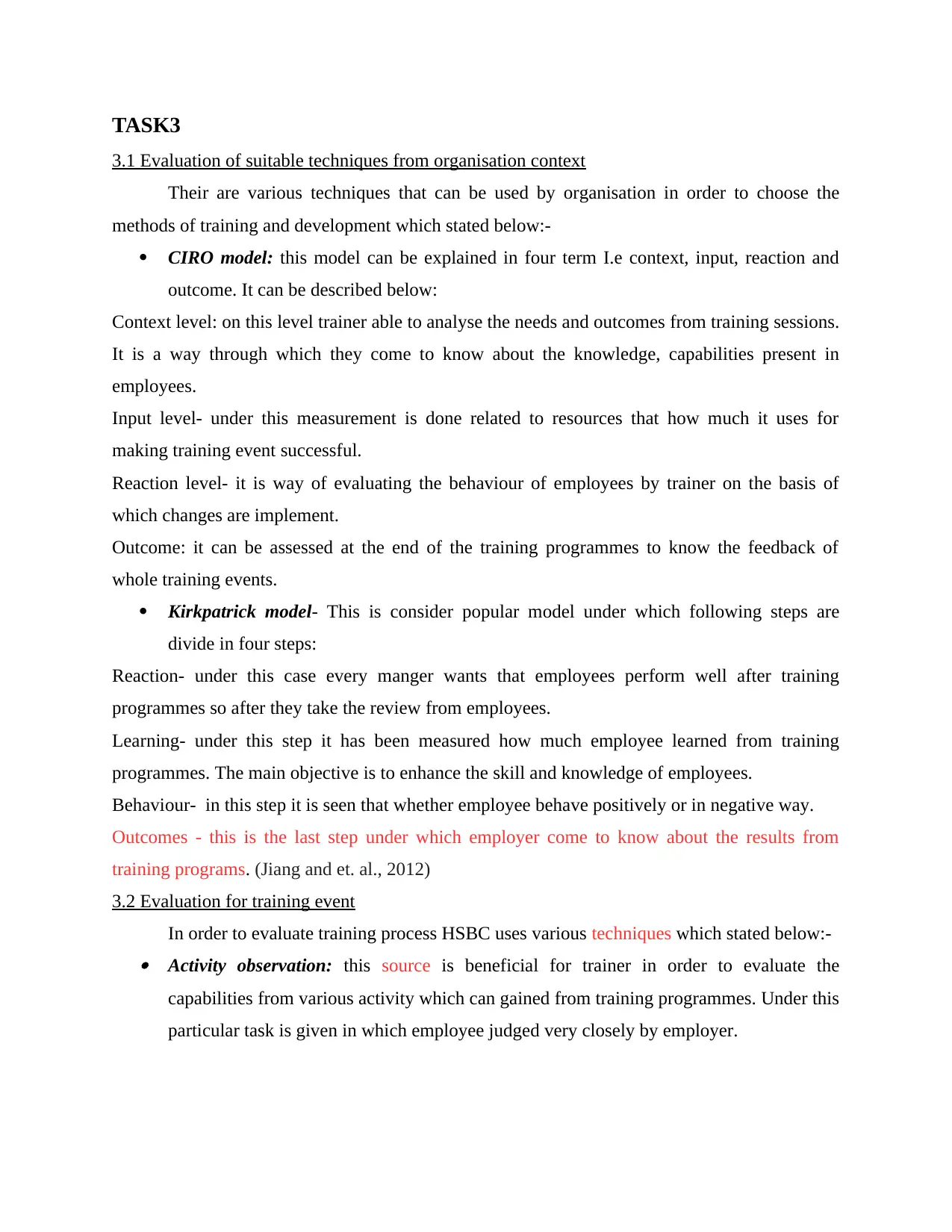
TASK3
3.1 Evaluation of suitable techniques from organisation context
Their are various techniques that can be used by organisation in order to choose the
methods of training and development which stated below:-
CIRO model: this model can be explained in four term I.e context, input, reaction and
outcome. It can be described below:
Context level: on this level trainer able to analyse the needs and outcomes from training sessions.
It is a way through which they come to know about the knowledge, capabilities present in
employees.
Input level- under this measurement is done related to resources that how much it uses for
making training event successful.
Reaction level- it is way of evaluating the behaviour of employees by trainer on the basis of
which changes are implement.
Outcome: it can be assessed at the end of the training programmes to know the feedback of
whole training events.
Kirkpatrick model- This is consider popular model under which following steps are
divide in four steps:
Reaction- under this case every manger wants that employees perform well after training
programmes so after they take the review from employees.
Learning- under this step it has been measured how much employee learned from training
programmes. The main objective is to enhance the skill and knowledge of employees.
Behaviour- in this step it is seen that whether employee behave positively or in negative way.
Outcomes - this is the last step under which employer come to know about the results from
training programs. (Jiang and et. al., 2012)
3.2 Evaluation for training event
In order to evaluate training process HSBC uses various techniques which stated below:- Activity observation: this source is beneficial for trainer in order to evaluate the
capabilities from various activity which can gained from training programmes. Under this
particular task is given in which employee judged very closely by employer.
3.1 Evaluation of suitable techniques from organisation context
Their are various techniques that can be used by organisation in order to choose the
methods of training and development which stated below:-
CIRO model: this model can be explained in four term I.e context, input, reaction and
outcome. It can be described below:
Context level: on this level trainer able to analyse the needs and outcomes from training sessions.
It is a way through which they come to know about the knowledge, capabilities present in
employees.
Input level- under this measurement is done related to resources that how much it uses for
making training event successful.
Reaction level- it is way of evaluating the behaviour of employees by trainer on the basis of
which changes are implement.
Outcome: it can be assessed at the end of the training programmes to know the feedback of
whole training events.
Kirkpatrick model- This is consider popular model under which following steps are
divide in four steps:
Reaction- under this case every manger wants that employees perform well after training
programmes so after they take the review from employees.
Learning- under this step it has been measured how much employee learned from training
programmes. The main objective is to enhance the skill and knowledge of employees.
Behaviour- in this step it is seen that whether employee behave positively or in negative way.
Outcomes - this is the last step under which employer come to know about the results from
training programs. (Jiang and et. al., 2012)
3.2 Evaluation for training event
In order to evaluate training process HSBC uses various techniques which stated below:- Activity observation: this source is beneficial for trainer in order to evaluate the
capabilities from various activity which can gained from training programmes. Under this
particular task is given in which employee judged very closely by employer.
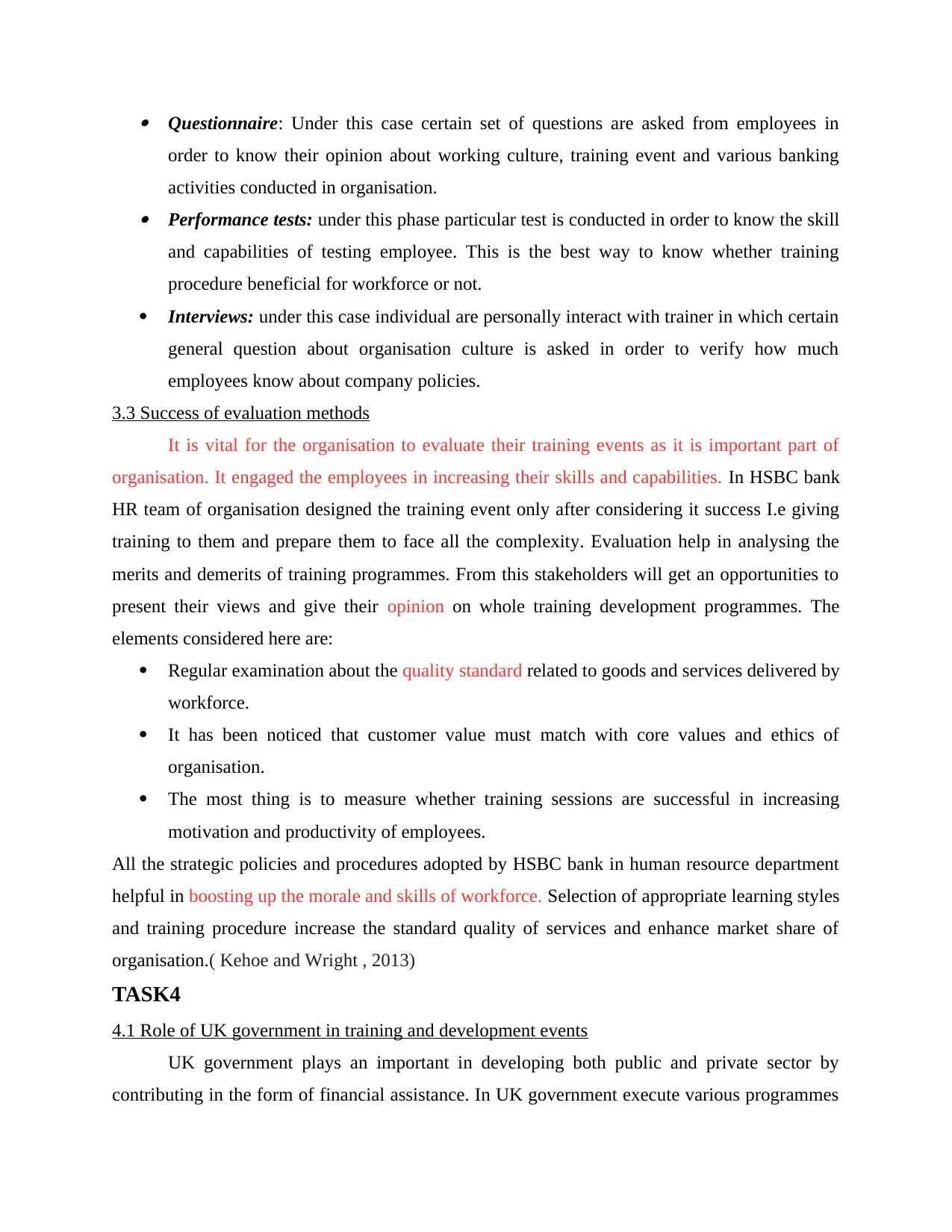
Questionnaire: Under this case certain set of questions are asked from employees in
order to know their opinion about working culture, training event and various banking
activities conducted in organisation. Performance tests: under this phase particular test is conducted in order to know the skill
and capabilities of testing employee. This is the best way to know whether training
procedure beneficial for workforce or not.
Interviews: under this case individual are personally interact with trainer in which certain
general question about organisation culture is asked in order to verify how much
employees know about company policies.
3.3 Success of evaluation methods
It is vital for the organisation to evaluate their training events as it is important part of
organisation. It engaged the employees in increasing their skills and capabilities. In HSBC bank
HR team of organisation designed the training event only after considering it success I.e giving
training to them and prepare them to face all the complexity. Evaluation help in analysing the
merits and demerits of training programmes. From this stakeholders will get an opportunities to
present their views and give their opinion on whole training development programmes. The
elements considered here are:
Regular examination about the quality standard related to goods and services delivered by
workforce.
It has been noticed that customer value must match with core values and ethics of
organisation.
The most thing is to measure whether training sessions are successful in increasing
motivation and productivity of employees.
All the strategic policies and procedures adopted by HSBC bank in human resource department
helpful in boosting up the morale and skills of workforce. Selection of appropriate learning styles
and training procedure increase the standard quality of services and enhance market share of
organisation.( Kehoe and Wright , 2013)
TASK4
4.1 Role of UK government in training and development events
UK government plays an important in developing both public and private sector by
contributing in the form of financial assistance. In UK government execute various programmes
order to know their opinion about working culture, training event and various banking
activities conducted in organisation. Performance tests: under this phase particular test is conducted in order to know the skill
and capabilities of testing employee. This is the best way to know whether training
procedure beneficial for workforce or not.
Interviews: under this case individual are personally interact with trainer in which certain
general question about organisation culture is asked in order to verify how much
employees know about company policies.
3.3 Success of evaluation methods
It is vital for the organisation to evaluate their training events as it is important part of
organisation. It engaged the employees in increasing their skills and capabilities. In HSBC bank
HR team of organisation designed the training event only after considering it success I.e giving
training to them and prepare them to face all the complexity. Evaluation help in analysing the
merits and demerits of training programmes. From this stakeholders will get an opportunities to
present their views and give their opinion on whole training development programmes. The
elements considered here are:
Regular examination about the quality standard related to goods and services delivered by
workforce.
It has been noticed that customer value must match with core values and ethics of
organisation.
The most thing is to measure whether training sessions are successful in increasing
motivation and productivity of employees.
All the strategic policies and procedures adopted by HSBC bank in human resource department
helpful in boosting up the morale and skills of workforce. Selection of appropriate learning styles
and training procedure increase the standard quality of services and enhance market share of
organisation.( Kehoe and Wright , 2013)
TASK4
4.1 Role of UK government in training and development events
UK government plays an important in developing both public and private sector by
contributing in the form of financial assistance. In UK government execute various programmes
⊘ This is a preview!⊘
Do you want full access?
Subscribe today to unlock all pages.

Trusted by 1+ million students worldwide
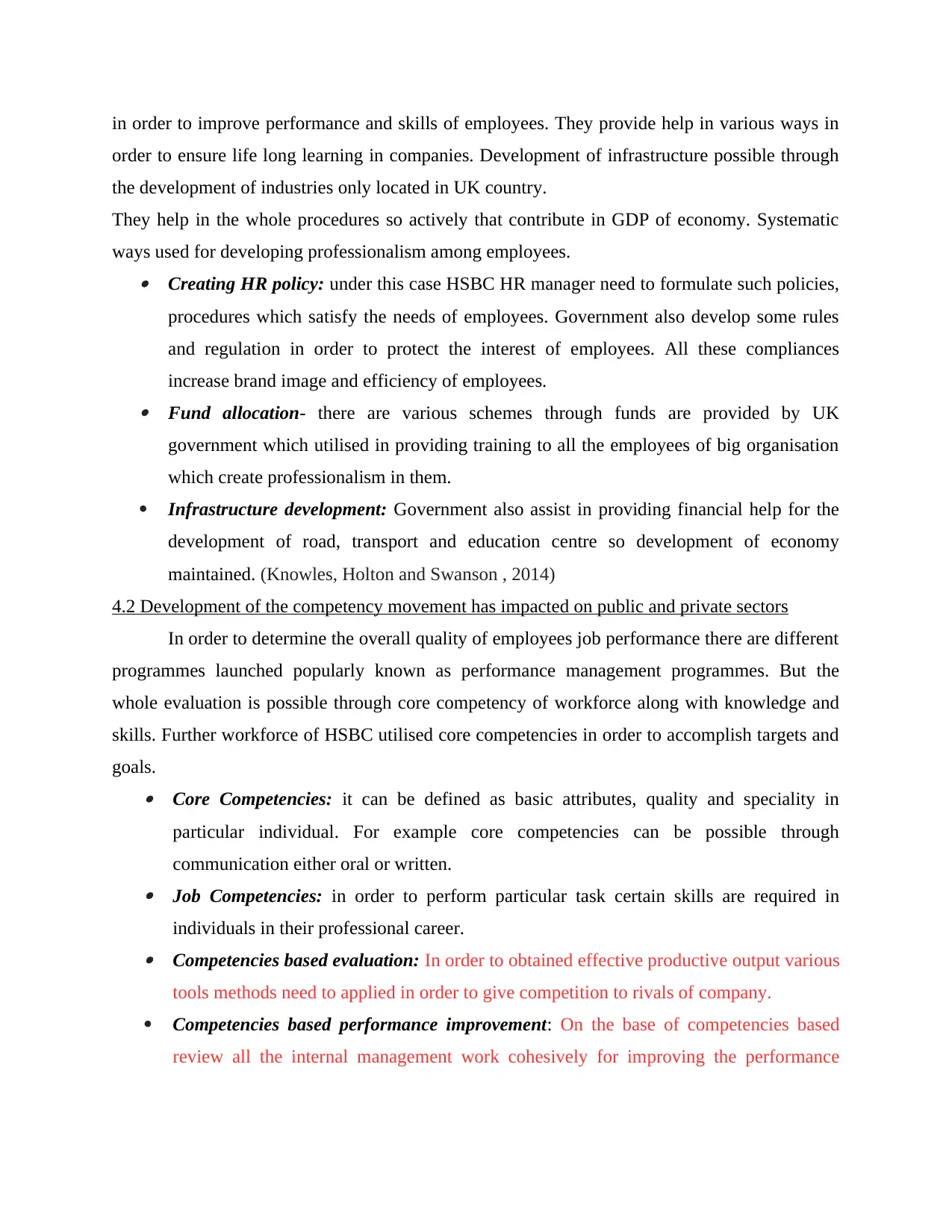
in order to improve performance and skills of employees. They provide help in various ways in
order to ensure life long learning in companies. Development of infrastructure possible through
the development of industries only located in UK country.
They help in the whole procedures so actively that contribute in GDP of economy. Systematic
ways used for developing professionalism among employees. Creating HR policy: under this case HSBC HR manager need to formulate such policies,
procedures which satisfy the needs of employees. Government also develop some rules
and regulation in order to protect the interest of employees. All these compliances
increase brand image and efficiency of employees. Fund allocation- there are various schemes through funds are provided by UK
government which utilised in providing training to all the employees of big organisation
which create professionalism in them.
Infrastructure development: Government also assist in providing financial help for the
development of road, transport and education centre so development of economy
maintained. (Knowles, Holton and Swanson , 2014)
4.2 Development of the competency movement has impacted on public and private sectors
In order to determine the overall quality of employees job performance there are different
programmes launched popularly known as performance management programmes. But the
whole evaluation is possible through core competency of workforce along with knowledge and
skills. Further workforce of HSBC utilised core competencies in order to accomplish targets and
goals. Core Competencies: it can be defined as basic attributes, quality and speciality in
particular individual. For example core competencies can be possible through
communication either oral or written. Job Competencies: in order to perform particular task certain skills are required in
individuals in their professional career. Competencies based evaluation: In order to obtained effective productive output various
tools methods need to applied in order to give competition to rivals of company.
Competencies based performance improvement: On the base of competencies based
review all the internal management work cohesively for improving the performance
order to ensure life long learning in companies. Development of infrastructure possible through
the development of industries only located in UK country.
They help in the whole procedures so actively that contribute in GDP of economy. Systematic
ways used for developing professionalism among employees. Creating HR policy: under this case HSBC HR manager need to formulate such policies,
procedures which satisfy the needs of employees. Government also develop some rules
and regulation in order to protect the interest of employees. All these compliances
increase brand image and efficiency of employees. Fund allocation- there are various schemes through funds are provided by UK
government which utilised in providing training to all the employees of big organisation
which create professionalism in them.
Infrastructure development: Government also assist in providing financial help for the
development of road, transport and education centre so development of economy
maintained. (Knowles, Holton and Swanson , 2014)
4.2 Development of the competency movement has impacted on public and private sectors
In order to determine the overall quality of employees job performance there are different
programmes launched popularly known as performance management programmes. But the
whole evaluation is possible through core competency of workforce along with knowledge and
skills. Further workforce of HSBC utilised core competencies in order to accomplish targets and
goals. Core Competencies: it can be defined as basic attributes, quality and speciality in
particular individual. For example core competencies can be possible through
communication either oral or written. Job Competencies: in order to perform particular task certain skills are required in
individuals in their professional career. Competencies based evaluation: In order to obtained effective productive output various
tools methods need to applied in order to give competition to rivals of company.
Competencies based performance improvement: On the base of competencies based
review all the internal management work cohesively for improving the performance
Paraphrase This Document
Need a fresh take? Get an instant paraphrase of this document with our AI Paraphraser
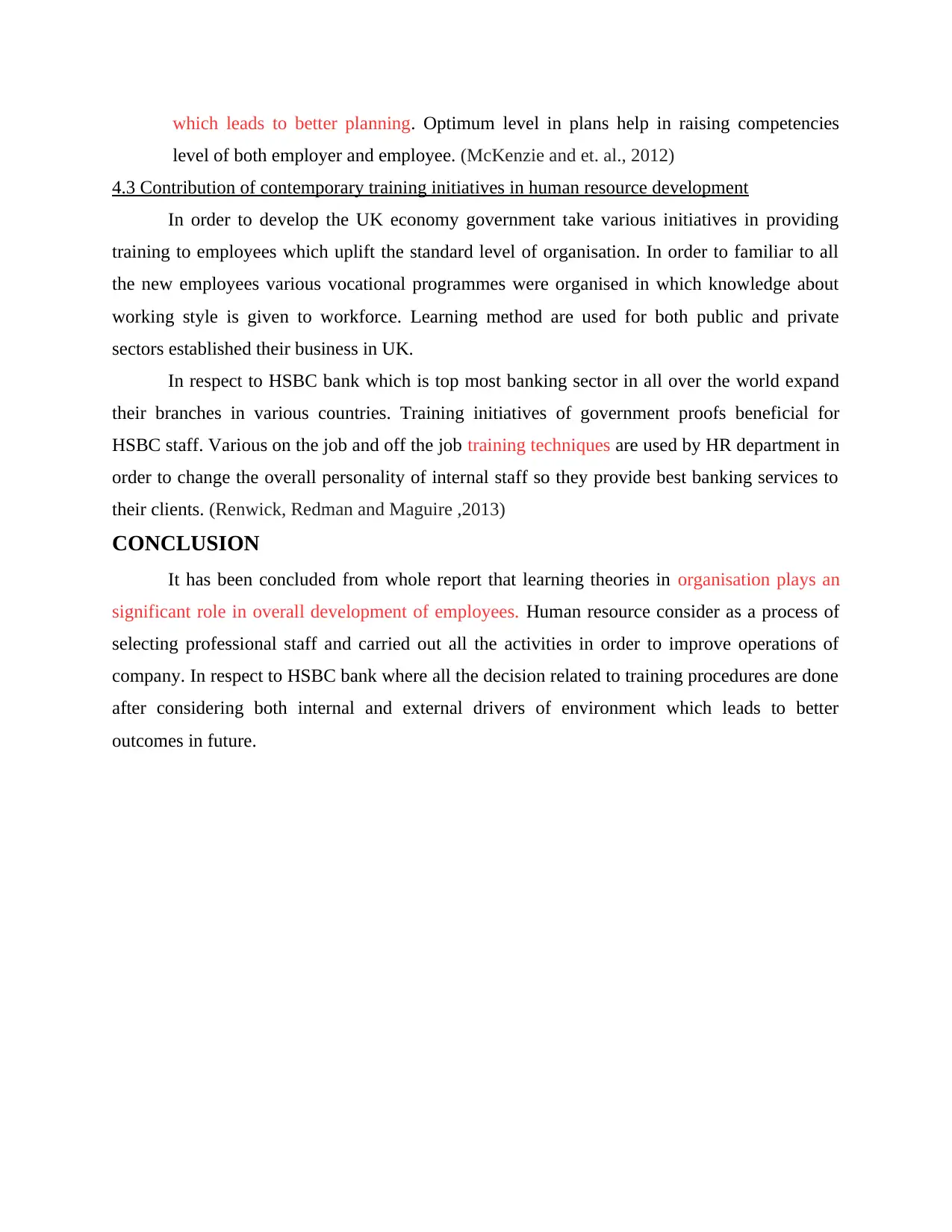
which leads to better planning. Optimum level in plans help in raising competencies
level of both employer and employee. (McKenzie and et. al., 2012)
4.3 Contribution of contemporary training initiatives in human resource development
In order to develop the UK economy government take various initiatives in providing
training to employees which uplift the standard level of organisation. In order to familiar to all
the new employees various vocational programmes were organised in which knowledge about
working style is given to workforce. Learning method are used for both public and private
sectors established their business in UK.
In respect to HSBC bank which is top most banking sector in all over the world expand
their branches in various countries. Training initiatives of government proofs beneficial for
HSBC staff. Various on the job and off the job training techniques are used by HR department in
order to change the overall personality of internal staff so they provide best banking services to
their clients. (Renwick, Redman and Maguire ,2013)
CONCLUSION
It has been concluded from whole report that learning theories in organisation plays an
significant role in overall development of employees. Human resource consider as a process of
selecting professional staff and carried out all the activities in order to improve operations of
company. In respect to HSBC bank where all the decision related to training procedures are done
after considering both internal and external drivers of environment which leads to better
outcomes in future.
level of both employer and employee. (McKenzie and et. al., 2012)
4.3 Contribution of contemporary training initiatives in human resource development
In order to develop the UK economy government take various initiatives in providing
training to employees which uplift the standard level of organisation. In order to familiar to all
the new employees various vocational programmes were organised in which knowledge about
working style is given to workforce. Learning method are used for both public and private
sectors established their business in UK.
In respect to HSBC bank which is top most banking sector in all over the world expand
their branches in various countries. Training initiatives of government proofs beneficial for
HSBC staff. Various on the job and off the job training techniques are used by HR department in
order to change the overall personality of internal staff so they provide best banking services to
their clients. (Renwick, Redman and Maguire ,2013)
CONCLUSION
It has been concluded from whole report that learning theories in organisation plays an
significant role in overall development of employees. Human resource consider as a process of
selecting professional staff and carried out all the activities in order to improve operations of
company. In respect to HSBC bank where all the decision related to training procedures are done
after considering both internal and external drivers of environment which leads to better
outcomes in future.
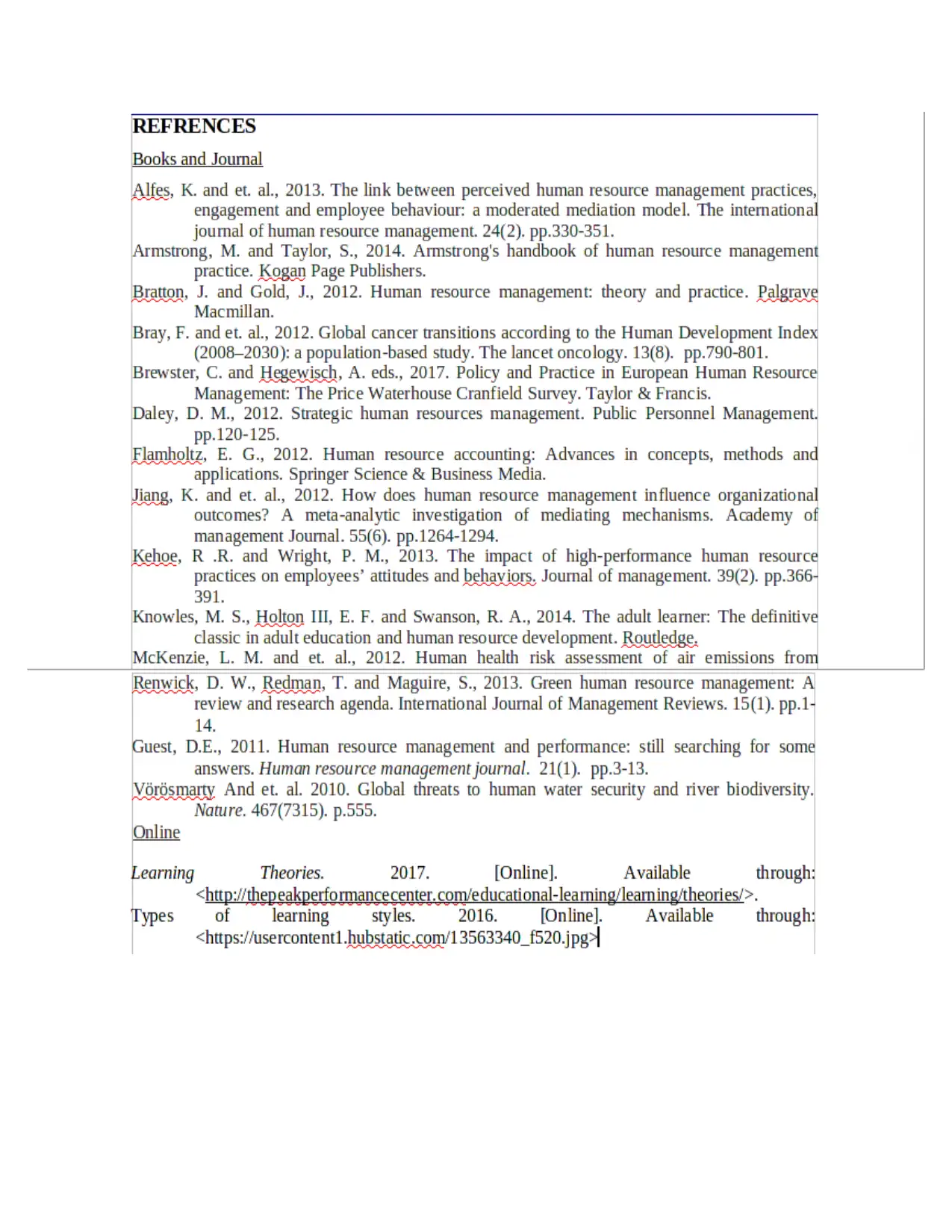
⊘ This is a preview!⊘
Do you want full access?
Subscribe today to unlock all pages.

Trusted by 1+ million students worldwide
1 out of 13
Related Documents
Your All-in-One AI-Powered Toolkit for Academic Success.
+13062052269
info@desklib.com
Available 24*7 on WhatsApp / Email
![[object Object]](/_next/static/media/star-bottom.7253800d.svg)
Unlock your academic potential
Copyright © 2020–2025 A2Z Services. All Rights Reserved. Developed and managed by ZUCOL.





